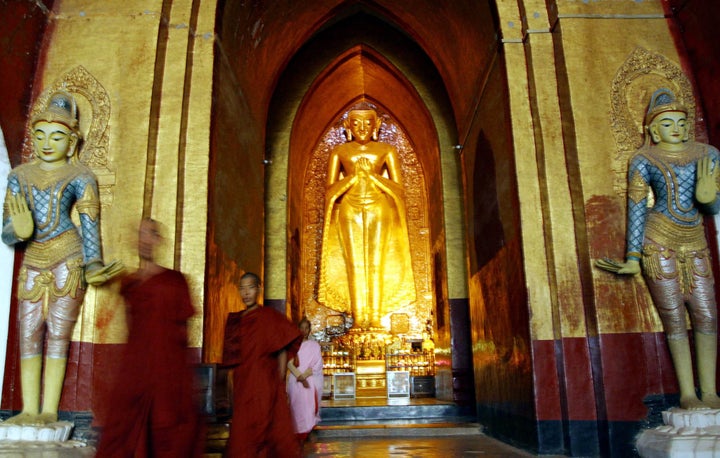
Anyone who's been in the spiritual world long enough knows that just about everything can be packaged as the latest, greatest way to get enlightened. Surrender everything, "manifest" everything, celebrate the body, abandon the body -- you name it, and both it and its opposite are the one sure-fire way to spiritual success.
That's why I love a pair of enlightenment stories in the Theravadan Buddhist tradition, which illustrate how what is needed for liberation is unique to each individual. The stories are of the Buddha himself, and his longtime aide and disciple, Ananda.
In the classic story of the Buddha's enlightenment, he sits under the Bodhi tree and resolves not to get up until he is fully liberated from suffering. Over the watches of a single night, he recalls all his past lives, goes through a series of trials and finally is besieged by Mara, the embodiment of all obstacles seekers face along the spiritual path. Mara, in a role similar to that of Satan in the story of Christ, tempts the Buddha with wealth, sensual pleasures and so on. Mara tries to terrify him. And finally, when all these and other tactics have failed, Mara assails the Buddha with his ultimate weapon: doubt.
Who are you, Mara says, that you deserve to be enlightened? Who do you think you are? In reply, the Buddha, in a gesture preserved in millions of images around the world, points to the Earth. The Earth has seen my efforts, in this life and previous ones, and can testify as my witness that I deserve to be enlightened. It's a beautiful moment of calm self-assurance (as well as a reminder of the importance of the natural world) and in the moment the Buddha points to the Earth, he becomes fully awakened. The "Yes" the Buddha silently utters is the key to his liberation.
Over 40 years later, shortly after the Buddha dies, his closest disciples call a meeting to record and clarify the Buddha's teachings. All of these disciples are arahants, fully enlightened beings, except for Ananda, who had followed the Buddha since his enlightenment. This posed a problem. The disciples, in order to ensure an accurate transmission of the teachings, needed Ananda there -- he had been present for more of the Buddha's discourses than anyone else. Yet the teachings also needed to be uncorrupted by selfish desire, and that meant everyone in the conference had to be an arahant.
The disciples turned to Ananda and told him to get to work. For decades, Ananda had been a "stream-enterer," one who had attained the first stage of enlightenment -- but this was not enough. Practice diligently, the disciples said, so that you can become an arahant and join us in this important meeting.
Ananda tried his best, meditating day and night. Yet the night before the meeting had come, and still he was only a stream-enterer. Undeterred, he kept practicing, entering deep states of concentration. But eventually, sleep overcame him, and Ananda realized he would not be able to attain arahantship. He made his peace with this failure, and prepared to go to sleep. And as he lay down to bed, he became fully enlightened.
Ananda's awakening story is the opposite of the Buddha's. Where the Buddha said "Yes," Ananda, in a sense, said "No." No, this attainment will not by mine -- and, we might add in our language, that's OK. Ananda's lying down is a moment of relinquishment, of admission. For 40 years, he had followed the Buddha, and watched countless other women and men become enlightened, while he did not. Can any of us imagine what that must have been like? And then, under the pressure of his peers and with a council that would determine the shape of the Buddha's legacy, to be unable to attain the same goal? The tradition does not record that Ananda lay down in defeat or despair. He simply recognized what was true and lay down to rest. He also lay down, we might say, the burden he had been carrying for decades. In this way, his "no" was really a "yes." In relinquishing the goal that he and others had set, he affirmed his truth. His surrender was total, and thus liberating.
In our own spiritual practice, all of us encounter moments of doubt such as those experienced by the Buddha and Ananda. What these two stories teach me is that there is no one sure-fire way to respond to them. Rather, diametrically opposed responses may each be appropriate. Perhaps, in the midst of a wave of doubt, what is called for is the Buddha's calm assertion. Yes, I do deserve this. I have done the work, and the Earth can testify to it. This is not arrogance or conceit -- after all, the Buddha has called a witness. It is an authentic confidence that calmly refutes the doubting voice.
Or perhaps the moment calls for Ananda's surrender. No, I cannot do it, and that will have to be enough. In the Theravadan Buddhist tradition, the last stage of understanding prior to awakening is called "high equanimity." In this stage, one must become so equanimous that one is even equanimous as between attaining enlightenment and not attaining it. This is where Ananda found himself on that night before the council. And it is where many of us practitioners can find ourselves along the path. Maybe that goal is beyond our reach; so it is.
In my experience, this kind of equanimity cannot be faked. You can't outwardly relinquish something while inwardly still hoping it will come to pass. It just doesn't work that way. The equanimity, and thus the relinquishment of a preference for one outcome or the other, has to be authentic. It's ironic, really; only by truly not wanting something can it be gained.
These days, thanks to the "law of attraction," the Buddha's model of awakening may seem more attractive than Ananda's. But in my experience, the spiritual life oscillates between both. Sometimes assertion, sometimes surrender; sometimes confidence, sometimes letting go. Personally, I am grateful for the multiplicity.
